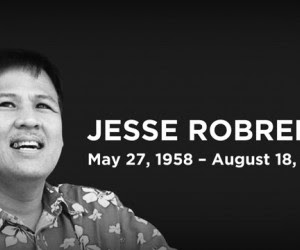Bell tolls too soon for a true
patriot; nation is amputated
By Alex P.
Vidal
“Any man's death diminishes me,
because I am involved in Mankind; And therefore never send to know for whom the
bell tolls; it tolls for thee.”
JOHN DONNE
LOS ANGELES, California -- As Ballsy Aquino-Cruz, eldest
daughter of the late former President Corazon Aquino and the late former
Senator Benigno “Ninoy” Aquno Jr. and sister of President Simeon “Noynoy” Aquino
succinctly sighed, “Matagal na kaming
beleb sa kanya (We have been impressed with him for a long time already).”
I have
interviewed Senator Franklin Drilon several times since he was labor secretary
under the Cory administration and he always put up an intrepid face even amid blitzkrieg
from MAD (Movement Against Drilon) provocateurs; but when he was interviewed by
Manila reporters shortly after DILG Secretary Jesse Robredo’s body was retrieved
from the private plane at the depth of around 180 feet resting upside down in the waters off
Masbate August 21, the senator from Iloilo bursts in tears like he lost his own
brother.
DOTC
Secretary Mar Roxas as well as the other cabinet officials of President Aquino
also grieved the loss of a “very sincere, honest and hard-working colleague”
who, despite his busy schedule, always had time to tutor his children and be
with his family during weekends.
So well-loved
was the man who became the Philippines’ youngest city mayor at 29 in 1988 that
the whole Naga city or the entire Camarines Sur for that matter grieved like a
nation that wept when President Ramon Magsaysay, the best ever Philippine
president, was killed in aircraft disaster on March 17, 1957.
PARELLEL
There indeed
was parallelism between Magsaysay and Robredo as public servants. Both were
active stalwarts of the Liberal Party; they were highly touted and much admired
by both their peers and supporters owing to their extraordinary methods in
governance and their Spartan-like lifestyles that is difficult to emulate in
today’s hodgepodge of modern leaders.
Those who
chronicled Robredo’s eye-catching styles as mayor of a hitherto mediocre city
that turned into bustling economic hub described him as a pragmatic go-getter who
buckled down to work and torpedoed inefficient bureaucracy and illegal gambling
as among his fast-tracked accomplishments that catapulted him into stardom when
he was awarded the Ramon
Magsaysay Award for Government Service in 2000, the first Filipino mayor so honored.
So colorful
was Robredo’s life that he was fancied as the perfect epitome of President
Aquino’s “Tuwid Na Daan” slogan in public service. For his constituents in
Naga, he was a simple guy who walked in slippers and plain shirt with no bodyguard.
For his subordinates in the DILG, “he was like one of us ordinary employees,”
they chorused. Robreo studied at Naga
Parochial School, a private Catholic school in Naga City, for his elementary education.
Robredo began to hone his talent and love for the game of chess while in
elementary. Naga Parochial School was known and had established a record for
winning Bicol's annual province-wide chess tournament and Robredo's brother had
been among its champion competitors.
Robredo
studied at Ateneo de Naga in 1970. In September 1972, when Robredo was in the
middle of high school, President Ferdinand Marcos declared Martial Law. Ateneo
de Naga and its administration immediately called for an assembly and warned
its students against getting involved in anti-government activities and efforts
that this may result to the school's exposure to the risk of closure.
DEGREES
Robredo
obtained his undergraduate degrees in Industrial Management Engineering and
Mechanical Engineering at De La Salle University. Robredo was an Edward Mason
Fellow and a graduate of Masters of Public Administration at John F. Kennedy
School of Government at Harvard University in Cambridge, Massachusetts in 1999.
In 1985, Robredo finished his Masters in Business Administration at the University
of the Philippines Diliman, Quezon City, as a scholar and was named the
Graduate School and Faculty Organization awardee for scholarly excellence.
Like
Magsaysay, Robredo came from a speaking engagement in Cebu representing the
President and was in a hurry to fly back to Naga to attend his daughter’s
swimming competition, when the Piper PA-34-200 Seneca I aircraft (registered
RP-C4431) crashed on August 18 at around 4:30 in the afternoon.
Magsaysay
left Manila for Cebu City on March 16, 1957 where he spoke at three educational
institutions. That same night, at about one o’clock in the morning, he boarded
the presidential plane "Mt. Pinatubo", a C-47, heading back to
Manila. In the early morning hours of 17 March, the plane was reported missing.
By late afternoon, newspapers had reported the airplane had crashed on Mt.
Manunggal in Cebu, and that 36 of the 56 aboard were killed (the actual number
on board was 25, including Magsaysay). Vice-President Carlos García, who was on
official visit to Australia at the time, assumed the presidency to serve out
the last eight months of Magsaysay's term.
An estimated
five million people attended Magsaysay's burial on March 31, 1957. He was
posthumously referred to by the people the "Idol of the Masses".
Only
newspaperman Nestor Mata survived the plane crash that killed Magsaysay. Police
Senior Insp. Jun Abrazado, Robredo’s bodyguard, was also the lone survivor.
When great
public servants like Magsaysay and Robredo perish at a time when their services
were needed most, the whole nation is amputated.

No comments:
Post a Comment